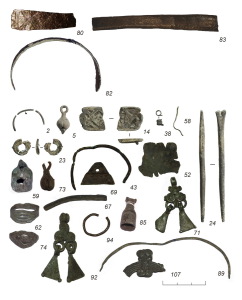Institute of Archaeology of RAS, Moscow (izaitseva@yandex.ru)
Keywords: medieval archaeology, Old Rus, alloys of non-ferrous metals.
The paper examines the composition of metal artefacts from copper alloys (107 items), metal remains on the walls of clay crucibles (32 items) and moulds (2 items) recovered from the settlements of Krutik and Nikolskoe V of the late 9th – early 11th century in the Beloe Lake area. A detailed analysis of samples shows that Krutik belonged to the brass zone. The latter existed at that time in Northern Europe including Northern Russia. Bronzes and copper are fewer. There is a small number of articles from totally mixed metals obtained as a result of repeated smelting. In spite of the availability of the local sources of copper and brass costume ornaments manufactured in Krutik workshops were made from either polynary (binary, ternary, etc.) or bronze alloys. Two parallel traditions coexisted on the same site. One of them fitted in northern European metalworking and implied work with brasses while the local tradition was focused on the treatment of bronzes and mixed alloys.








